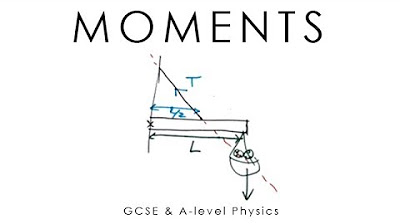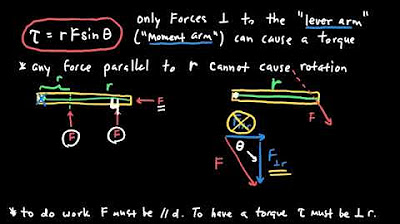Center of mass | Impacts and linear momentum | Physics | Khan Academy
TLDRThis presentation delves into the concept of the center of mass, a pivotal point that simplifies the analysis of an object's motion. It explains how the center of mass can be intuitively understood and has practical applications, such as in high jumping where athletes use it to clear bars with less force. The script also touches on the difference between force applied at the center of mass and away from it, leading to translational or rotational motion, respectively, and hints at the upcoming topic of torque.
Takeaways
- 📚 The center of mass is a point where the entire mass of an object can be considered to be concentrated for the purpose of motion analysis.
- 🔍 The center of mass does not necessarily have to be within the physical bounds of the object; it can be located outside the object.
- 🏋️ If the center of mass is known, the behavior of the object under force can be predicted without considering its shape.
- 📏 For objects with uniform density, the center of mass coincides with the geometric center of the object.
- 📐 In the case of non-uniform density, the center of mass is determined by the distribution of mass, not just the geometric center.
- 🤸♂️ High jumpers use the concept of center of mass to their advantage by arching their backs to lower their center of mass, allowing them to clear the bar with less force.
- 🔄 When a force is applied at the center of mass, the object accelerates in the direction of the force as if it were a point mass.
- 🌀 If a force is applied away from the center of mass, the object will rotate around the center of mass instead of translating.
- 🚀 The center of mass concept is fundamental in understanding the motion of objects under various forces, including in space where objects rotate freely.
- 🔧 The center of mass is a critical concept in physics, with applications in everyday activities and sports, such as high jumping.
- 🔬 Understanding the center of mass helps in analyzing the stability and motion of objects, which is essential in engineering and physics.
Q & A
What is the center of mass and why is it significant?
-The center of mass is a point at which the entire mass of an object can be considered to be concentrated for the purpose of analyzing its motion. It is significant because it allows us to predict the motion of an object under the influence of a force, especially when the force is applied at the center of mass.
Can the center of mass be located outside the physical boundaries of an object?
-Yes, the center of mass does not necessarily have to be within the physical boundaries of an object. It can be outside if the mass distribution of the object is not uniform.
How does the center of mass relate to the motion of an object under a force?
-If a force is applied at the center of mass, the object will accelerate in the direction of the force as if all its mass were concentrated at that point, following Newton's second law of motion.
What is the center of mass of a uniformly distributed object?
-For an object with a uniform mass distribution, the center of mass coincides with its geometric center.
How does the density of an object affect the location of its center of mass?
-The center of mass is affected by the density of the object. If the density is not uniform, the center of mass will be closer to the denser regions.
What happens when a force is applied away from the center of mass?
-When a force is applied away from the center of mass, the object tends to rotate around the center of mass instead of translating in the direction of the force.
Why is the center of mass concept important in sports like high jumping?
-In high jumping, athletes arch their backs to lower their center of mass as they clear the bar, which allows them to jump higher with the same amount of force or clear a higher bar with the same force.
How can you determine the center of mass of a complex object?
-For complex objects, the center of mass can be determined by integrating the mass distribution over the entire object and finding the average location of mass.
What is the relationship between the center of mass and torque?
-Torque is the rotational equivalent of force and is related to the distance from the point where the force is applied to the center of mass. The further the force is from the center of mass, the greater the torque.
Can the center of mass be used to predict the stability of an object?
-Yes, the center of mass can be used to predict the stability of an object. An object is more stable if its center of mass is lower and closer to its base of support.
What is the practical application of understanding the center of mass in everyday life?
-Understanding the center of mass is useful in various everyday activities, such as lifting heavy objects, maintaining balance, and in sports techniques like high jumping, as mentioned in the script.
Outlines
🔄 Introduction to the Center of Mass
The script introduces the concept of the center of mass, explaining it as an intuitive point where the entire mass of an object can be considered to be concentrated for the purpose of motion analysis. It uses the example of a ruler to illustrate that if a force is applied at the center of mass, the object will accelerate as if it were a point mass with the same mass. The explanation highlights that the center of mass may not necessarily be within the physical bounds of the object itself. The concept is further clarified by stating that for objects with uniform density, the center of mass coincides with the geometric center, but this is not the case for objects with non-uniform density, as demonstrated with a square made of lead and styrofoam. The script also touches on the implications of applying force at the center of mass versus away from it, leading to translational versus rotational motion.
🤸♂️ Center of Mass in Action: High Jumping and Everyday Applications
This paragraph delves into the practical applications of the center of mass, particularly in the context of high jumping. It explains how understanding the center of mass allows athletes to clear a bar without having to lift their entire body mass over it, by arching their back to lower the effective center of mass. This technique requires less force and can enable the jumper to clear a higher bar with the same effort. The script also briefly mentions the concept of torque, which will be discussed in a subsequent video, and emphasizes the relevance of the center of mass in various everyday scenarios, including the rotation of objects in space and the behavior of objects when thrown.
Mindmap
Keywords
💡Center of Mass
💡Uniform Distribution
💡Geometric Center
💡Density
💡Force
💡Acceleration
💡Point Mass
💡Rotation
💡Torque
💡High Jumping
💡Projectile Motion
Highlights
The center of mass is an intuitive concept representing a point where the entire mass of an object can be considered to act.
The center of mass does not necessarily have to be within the physical bounds of the object.
If the center of mass is known, the behavior of an object under force can be predicted without considering its shape.
For objects with uniform density, the center of mass coincides with the geometric center.
In the case of non-uniform density, the center of mass shifts towards the denser material.
Applying force directly at the center of mass results in linear motion of the object.
Applying force away from the center of mass causes the object to rotate around the center of mass.
The center of mass is the point around which objects rotate in free space, such as in the example of a thrown monkey wrench.
High jumpers utilize the concept of center of mass by arching their back to lower it, requiring less force to clear the bar.
Understanding the center of mass is crucial for predicting the motion of objects under various forces.
The concept of center of mass simplifies the analysis of complex objects by allowing us to treat them as point masses.
The center of mass can be determined by considering both the shape and density distribution of an object.
The ruler example illustrates how the center of mass can be estimated and its implications for object behavior.
The center of mass is fundamental in understanding the stability and motion of objects in physics.
The presentation provides a practical application of center of mass in sports, specifically high jumping.
The video concludes with a teaser for the next topic, torque, and its relation to rotational motion.
The center of mass is a fundamental concept that has wide-ranging applications in physics and everyday life.
Transcripts
Browse More Related Video

Introduction to torque | Moments, torque, and angular momentum | Physics | Khan Academy

Inertia - Basic Introduction, Torque, Angular Acceleration, Newton's Second Law, Rotational Motion

Moments, Torque, Toppling & Couples - GCSE & A-level Physics (full version)

GCSE Physics - Forces 5 - Moments and Centre of Mass

Physical Pendulum

AP Physics 1 Torque and Rotational Motion Review
5.0 / 5 (0 votes)
Thanks for rating: